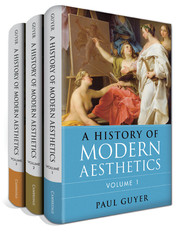Book contents
- Volume 1 The Eighteenth Century
- Volume 2 The Nineteenth Century
- Volume 3 The Twentieth Century
- Frontmatter
- Contents
- Acknowledgments
- Introduction
- Part One German Aesthetics in the Twentieth Century
- Part Two Aesthetics in Britain until World War II
- Part Three American Aesthetics in the First Half of the Twentieth Century
- 6 Santayana
- 7 The American Reception of Expression Theory I
- 8 Dewey
- 9 The American Reception of Expression Theory II
- 10 After Dewey and Cassirer
- Part Four Wittgenstein and After
- Bibliography
- References
7 - The American Reception of Expression Theory I
Parker to Greene
from Part Three - American Aesthetics in the First Half of the Twentieth Century
Published online by Cambridge University Press: 05 June 2015
- Volume 1 The Eighteenth Century
- Volume 2 The Nineteenth Century
- Volume 3 The Twentieth Century
- Frontmatter
- Contents
- Acknowledgments
- Introduction
- Part One German Aesthetics in the Twentieth Century
- Part Two Aesthetics in Britain until World War II
- Part Three American Aesthetics in the First Half of the Twentieth Century
- 6 Santayana
- 7 The American Reception of Expression Theory I
- 8 Dewey
- 9 The American Reception of Expression Theory II
- 10 After Dewey and Cassirer
- Part Four Wittgenstein and After
- Bibliography
- References
Summary
The dominant figure in American aesthetics in the first half or almost two-thirds of the twentieth century was certainly John Dewey, whose Art as Experience was published midway through this period, in 1934. Dewey’s influence remains visible in the work of Monroe Beardsley, the leading American aesthetician from the 1940s through the 1960s, whose 1958 Aesthetics: Problems in the Philosophy of Criticism builds upon Dewey’s central idea of “consummatory experience.” To be sure, there is an alternative stream of aesthetic thought, from the work of Susanne Langer in the 1940s and 1950s, in turn inspired by the philosophy of Ernst Cassirer, to the widely discussed Languages of Art by Nelson Goodman, which forgoes discussion of aesthetic experience in favor of a focus upon the function of language and other symbolic systems in works of art. This difference in emphasis between consummatory experience, on the one hand, and the languages of art, on the other, can be seen as a manifestation of the fundamental divide between theories of art and aesthetic experience as a form of play and cognitive theories of art, although as we will see Dewey himself, like many of the German and British theorists of expression whom we have considered, tried to distance his view from Kant and the play theory. Before we turn to Dewey, however, it will be worth pausing over several American aestheticians who published their chief works in the 1920s and, like the British aestheticians of that period, defined their own positions by their to be sure qualified acceptance of Croce’s theory of art as expression. These are the University of Michigan philosopher DeWitt Henry Parker, the Brown philosopher Curt John Ducasse, the Harvard philosopher David Wight Prall, and the Princeton professor Walter T. Stace. In this chapter we will also discuss the aesthetics of Theodore M. Greene, who taught at Princeton and then Yale; his main work in aesthetics came out after Dewey’s book, but his views were already developing before Dewey’s book appeared.
- Type
- Chapter
- Information
- A History of Modern Aesthetics , pp. 265 - 308Publisher: Cambridge University PressPrint publication year: 2014



